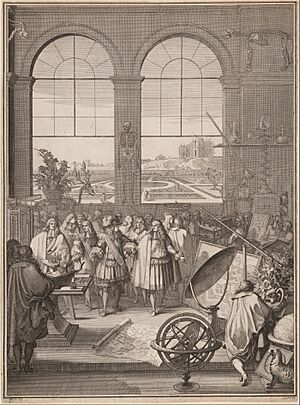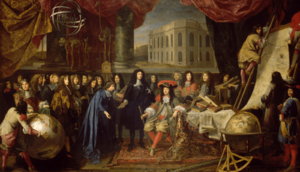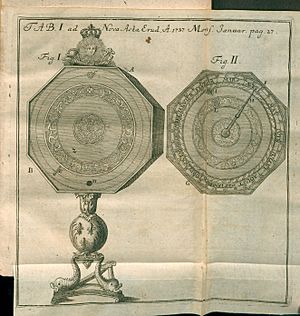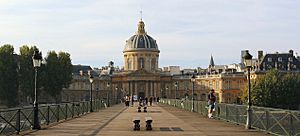French Academy of Sciences facts for kids
The French Academy of Sciences (French: Académie des sciences) is a special group of smart people, started in 1666 by Louis XIV, the King of France. He got the idea from Jean-Baptiste Colbert. The main goal was to help and protect French scientific research. For a long time, in the 1600s and 1700s, it was a leader in science across Europe. It's one of the very first groups like it.
Today, Patrick Flandrin is the President. The Academy is one of five Academies that make up the Institut de France.
Contents
How the Academy Started
The idea for the Academy of Sciences came from Colbert, who wanted to create a big academy for many different fields. On December 22, 1666, he picked a small group of scholars. They started meeting twice a week in the King's library in Paris. For the first 30 years, the Academy worked without many official rules.
Unlike similar groups in Britain, the French Academy was set up by the government. It was hard to become a member because there were not many spots. The election process was very detailed, with many steps. Members would talk about who should join, even in private. Sometimes, new members would start as an "associate" or "correspondent" before becoming a full member.
At first, if a spot opened up, it had to be filled by someone in the exact same field. For example, if a mathematician left, only another mathematician could take their place. This meant some fields might not have specialists for a while.
In 1987, the Academy changed this rule. They started filling spots with people from new fields. This helped bring in more diverse knowledge and younger members. The Academy was expected to stay out of politics and avoid talking about religious or social issues.

On January 20, 1699, King Louis XIV gave the Academy its first official rules. It was renamed the Royal Academy of Sciences and moved to the Louvre Palace in Paris. After this, the Academy began publishing a book each year. This book shared all the work done by its members and remembered those who had passed away. The new rules also set up how members could get money for their work after they retired.
The Academy was organized into different groups: Pensionaires, Pupils, Honoraires, and Associés. New groups like Vétéran were added later. The Honoraires group, whose members were chosen directly by the King, existed until 1793.
The Academy had more than 100 full members for the first time in 1976. This was 310 years after it started! With this growth, the Academy was reorganized. It could then have 130 resident members, 160 corresponding members, and 80 foreign members.
Members usually stay for life, so a spot only opens when someone passes away. To encourage younger scientists, half of the new spots are saved for people under 55 years old.
The 1976 reorganization also split the Academy into two main parts:
- Division 1: For Mathematical and Physical sciences and how they are used.
- Division 2: For Chemical, Biological, and Medical sciences and how they are used.
Changes Over Time
On August 8, 1793, during a big change in France, all the academies were closed. But on August 22, 1795, a new group called the National Institute of Sciences and Arts was created. It brought together the old academies, including the Academy of Sciences.
In 1795, the Academy decided on 10 main areas of science they would focus on:
- Mathematics
- Mechanics
- Astronomy
- Physics
- Chemistry
- Mineralogy
- Botany
- Agriculture
- Anatomy and Zoology
- Medicine and Surgery
The last two areas were combined because many talented people wanted to join in those fields. Even brilliant scientists like François Magendie, who made huge discoveries in Physiology with his hands-on experiments, couldn't get his study into its own category. Magendie became an official member in 1821. He and anatomist Charles Bell later created the famous "Bell–Magendie law".
From 1795 until World War I (which started in 1914), the French Academy of Science was the most important science group in France. Most of the old members who had been removed were re-elected. Even Napoleon Bonaparte became a member in 1798 and president three years later. This was partly because of his trip to Egypt, which included scientific studies.
In 1816, the Academy was renamed the "Royal Academy of Sciences" again. It became independent but was still part of the Institute of France. The leader of France became its supporter. Later, during the French Second Republic, its name went back to Académie des sciences. During this time, the Academy received money from the government.
The Academy also helped control French patent laws in the 1700s. This meant they helped share the knowledge of skilled workers with everyone. Because of this, Academy members were very important in new technologies in France.
The Academy's work was published in a series called Comptes rendus de l'Académie des Sciences from 1835 to 1965. Today, it's a journal series with seven different titles. You can find these publications at the French National Library.
In 1818, the Academy held a competition to explain how light works. A civil engineer named Augustin-Jean Fresnel presented a new idea: the wave theory of light. Siméon Denis Poisson, one of the judges, studied Fresnel's idea closely. Poisson believed light was made of tiny particles, so he tried to prove Fresnel wrong. He thought he found a problem: Fresnel's theory predicted a bright spot in the middle of a shadow cast by a round object, where it should be completely dark. This "Poisson spot" is not easy to see every day, so Poisson thought it was a silly idea that proved Fresnel wrong.
However, the head of the committee, François Arago, decided to try the experiment. He used a 2-millimeter metal disk. To everyone's surprise, he saw the bright spot exactly where Fresnel's theory said it would be! This experiment convinced most scientists that light acts like a wave.
For three centuries, women were not allowed to be members of the Academy. This meant many amazing women scientists were left out. This included Marie Curie, who won the Nobel Prize twice, and Irène Joliot-Curie, another Nobel winner. The first woman to become a "correspondent member" was Marguerite Perey in 1962, who was a student of Marie Curie. The first woman to become a full member was Yvonne Choquet-Bruhat in 1979.
The Academy tries to have members who reflect the general population of France. As the French population grew and changed in the early 2000s, the Academy updated its rules in 2002 to include more people.
Most members stay in the Academy for their whole lives. Very few are ever removed. The last time a member was removed was in 1944. Reasons for removal included not doing enough work, leaving the country, or political reasons.
Government's Role
The government had the most direct say when members were first chosen in 1795. However, most of these members had already been part of the old academies, so there weren't many complaints. After that, these chosen members were free to pick the rest. Members expected to stay for life, but sometimes the government would end someone's membership for political reasons.
Another time the government stepped in was when they didn't agree with the Academy's election results. In 1803, Napoleon Bonaparte reorganized the Academy. He was especially concerned about the Second class, which included political scientists who might criticize his government. Bonaparte completely got rid of the Second class. After removing a few members, he put the remaining ones into new groups. Still, this relationship wasn't just one-sided; members expected to get paid for their work.
Challenges and Decline
Even though the Academy still exists today, its reputation was questioned after World War I. One reason for this was a shift from choosing members based on their scientific skill to choosing them based on how long they had been around. It became more like a "hall of fame" and lost some of its control over French science. Another reason was that funding for science dropped a lot between 1909 and 1914, leading to money problems in France.
The Academy Today
Today, the Academy is one of five academies that make up the Institut de France. Its members are chosen for life. Currently, there are 150 full members, 300 corresponding members, and 120 foreign members. They are divided into two main science groups:
- The Mathematical and Physical sciences and their uses.
- The Chemical, Biological, Geological, and Medical sciences and their uses.
The Academy has five main goals:
- Encouraging scientific life.
- Promoting science education.
- Sharing knowledge between scientists.
- Helping with international science projects.
- Giving expert advice.
The French Academy of Science started a program in 1997 to work with African countries. Since then, they have expanded their work to other parts of the world. A special committee called COPED handles these international projects. The current president of COPED is Pierre Auger. COPED has held many workshops in Paris, bringing together people from African academies and research centers. They discuss important topics like higher education in science and research in areas like renewable energy, diseases, animal health, food, clean water, farming, and city health.
Committees and Groups
The Academy has many committees and working groups. These groups prepare advice, policy statements, and reports. Some are required by law, like the Committee for International Affairs. Others are created when needed and approved by the Academy members.
Some of the Academy's current committees and working groups include:
- The Committee for the Biennial Report on Science and Technology
- The Committee for Science, Ethics, and Society
- The Committee for the Environment
- The Committee for Space Research
- The Committee for Science and Measurement
- The Committee for Science History and How We Learn
- The Committee for Science and Safety Issues
- The Committee for Science Education and Training
- The "La main à la pâte" Committee (focused on hands-on science education)
- The Committee for the Defense of Scientists' Rights (CODHOS)
- The Committee for International Affairs (CORI)
- The French Committee for International Scientific Unions (COFUSI)
- The Committee for Scientific and Technological International Relations (CARIST)
- The Committee for Developing Countries (COPED)
- The Inter-academic Group for Development (GID)
- The Commission for Sealed Deposits (for secret scientific work)
- The Committee for New Words and Terms
- The Antoine Lavoisier Committee
- The Committee for Future Energy Sources
- The Working Group on Scientific Computing
- The Working Group on Material Sciences and Engineering
Awards and Prizes
Each year, the Academy of Sciences gives out about 80 prizes. Some of these include:
- Marie Skłodowska-Curie and Pierre Curie Polish-French Science Award (started in 2022).
- The Grande Médaille, given every year to a French or foreign scholar who has greatly helped science.
- The Lalande Prize, given from 1802 to 1970 for great work in astronomy.
- The Valz Prize, given from 1877 to 1970 for advances in astronomy.
- The Richard Lounsbery Award, given with the United States National Academy of Sciences.
- The Prix Jacques Herbrand, for mathematics and physics.
- The Prix Paul Pascal, for chemistry.
- The Louis Bachelier Prize for important work in mathematical modeling for finance.
- The Prix Michel Montpetit for computer science and applied mathematics (since 1977).
- The Leconte Prize, given every year since 1886, for important discoveries in mathematics, physics, chemistry, natural history, or medicine.
- The Prix Tchihatcheff.
Important People
Here are some of the leaders of the Academy over the years:
Presidents
- 1800 Napoleon Bonaparte
- 1906 Henri Poincaré
- 1952 Albert Caquot
- 2001–2002 Hubert Curien
- 2003–2004 Étienne-Émile Baulieu
- 2005–2006 Édouard Brézin
- 2007–2008 Jules Hoffmann
- 2009–2010 Jean Salençon
- 2011–2012 Alain Carpentier
- 2013–2014 Philippe Taquet
- 2015–2016 Bernard Meunier
- 2017–2018 Sébastien Candel
- 2019–2020 Pierre Corvol
- 2021–2022 Patrick Flandrin
Treasurers
- ?–1788 Georges-Louis Leclerc, Comte de Buffon
- 1788–1791 Mathieu Tillet
Permanent Secretaries
General Secretaries
- Dec 1666 – Apr 1668 Jean-Baptiste Du Hamel
- Apr 1668 – Dec 1669 Jean Gallois
- Jan 1670 – Jan 1697 Jean-Baptiste Du Hamel
- Jan 1697 – Dec 1740 Bernard le Bovier de Fontenelle
- Jan 1741 – Aug 1743 Jean-Jacques Dortous de Mairan
- Sep 1743 – Jul 1776 Jean-Paul Grandjean de Fouchy
- Aug 1777 – Aug 1793 Nicolas Caritat, marquis de Condorcet
Mathematical Sciences Secretaries
- 1801–1822 Jean Baptiste Joseph Delambre
- 1822–1830 Joseph Fourier
- 1830–1853 François Arago
- 1853–1874 Léonce Élie de Beaumont
- 1874–1900 Joseph Bertrand
- 1900–1917 Gaston Darboux
- 1917–1942 Émile Picard
- 1942–1975 Louis de Broglie
- 1975–1996 Paul Germain
- Currently: Jean Dercourt
- Currently: Odile Macchi
Physical Sciences Secretaries
- 1795–1803 Bernard Germain de Lacépède
- 1803–1832 Georges Cuvier
- 1832–1833 Pierre-Louis Dulong
- 1833–1868 Pierre Flourens
- 1868–1884 Jean-Baptiste Dumas
- 1884–1886 Jules Jamin
- 1886–1887 Alfred Vulpian
- 1887–1889 Louis Pasteur
- 1889–1907 Marcelin Berthelot
- 1907 Albert de Lapparent
- 1908 Henri Becquerel
- 1908–1914 Philippe van Tieghem
- 1914–1948 Alfred Lacroix
Chemistry and Biology Secretaries
- 1948–1986 Robert Courrier
- 1986–1991 Alfred Jost
- 1991–2001 François Gros
- 2001–2006 Nicole Le Douarin
- 2006–2011 Jean-François Bach
- Currently Catherine Bréchignac
- Currently Ilan Marek
See also
 In Spanish: Academia de Ciencias de Francia para niños
In Spanish: Academia de Ciencias de Francia para niños
- French art salons and academies
- French Geodesic Mission
- History of the metre
- Seconds pendulum
- Royal Commission on Animal Magnetism




